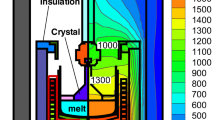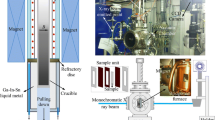Abstract
Traveling magnetic field (TMF) is a potential method to control the melt flow and impurity transport during the directional solidification (DS) of silicon ingots. We numerically study the control mechanism of a downward and an upward TMF with different frequencies on the silicon melt flow and oxygen distribution in the DS process. Model experiment of generation and measurement of a TMF is first carried out to validate the magnetic field computing program. Then, the TMF frequency is varied to study its influence on the direction and magnitude of Lorentz force, pattern and intensity of silicon melt flow, and distribution of oxygen impurity. Results show that the downward TMF with large frequency can induce local melt flow above the melt-crystal interface and block the oxygen transport from the dominant flow to the interface. The upward TMF with small frequency and large amplitude can induce thoroughly upward melt flow along the crucible side wall and take the oxygen far away from the melt-crystal interface, which is better for reducing the oxygen content in the silicon melt and ingots.
Similar content being viewed by others
References
Kerkar F, Kheloufi A, Dokhan N, Ouadjaout D, Belhousse S, Medjahed S, Meribai N, Laib K (2019) Silicon. https://doi.org/10.1007/s12633-019-00154-0
Srinivasan M, Ramasamy P (2017). Silicon 9(1):7–16
Lan CW, Hsu C, Nakajima K (2015) In: Nishinga T, Rudolph P (eds) handbook of crystal growth, vol 2A. 2nd edn., p 381
Dadzis K, Ehrig J, Niemietz K, Patzold O, Wunderwald U, Friedrich J (2011). J Cryst Growth 333(1):7–15
Dropka N, Miller W, Menzel R, Rehse U (2010). J Cryst Growth 312(8):1407–1410
Rudolph R, Kakimoto K (2009). MRS Bull 34(4):251–258
Kiessling FM, Bullesfeld F, Dropka N, Frank-Rotsch C, Muller M, Rudolph P (2012). J Cryst Growth 360:81–86
Dadzis K, Vizman D, Friedrich J (2013). J Cryst Growth 367:77–87
Vizman D, Dadzis K, Friedrich J (2013). J Cryst Growth 381:169–178
Yu QH, Liu LJ, Li ZY, Su P (2014). J Cryst Growth 401:285–290
Yu QH, Liu LJ, Li ZY, Shao Y (2018). Int J Heat Fluid Fl 71:55–67
Tavakoli MH, Omid S, Mohammadi-Manesh E (2011). CrystEngComm 13(16):5088–5093
Honarmandnia M, Tavakoli MH, Sadeghi H (2016). CrystEngComm 18(21):3942–3948
Li ZY, Liu LJ, Nan XH, Kakimoto K (2012). J Cryst Growth 346(1):40–44
Liu LJ, Kakimoto K (2005). Int J Heat Mass Transf 48(21–22):4481–4491
Matsuo H, Ganesh RB, Nakano S, Liu LJ, Kangawa Y, Arafune K, Ohshita Y, Yamaguchi M, Kakimoto K (2008). J Cryst Growth 310(22):4666–4671
Togawa S, Huang XM, Izunome K, Terashima K, Kimura S (1995). J Cryst Growth 148(1–2):70–78
Kudla C, Blumenau AT (2013) Bullesfeld F, etc. J Cryst Growth 365:54–58
Acknowledgments
This research was supported by the National Natural Science Foundation of China (Grant Nos. 51406156, 51606135), and Natural Science Basic Research Plan in Shaanxi Province of China (Grant No. 2016JQ5005).
Author information
Authors and Affiliations
Corresponding authors
Additional information
Publisher’s Note
Springer Nature remains neutral with regard to jurisdictional claims in published maps and institutional affiliations.
Rights and permissions
About this article
Cite this article
Shao, Y., Li, Z., Yu, Q. et al. Control of Melt Flow and Oxygen Distribution Using Traveling Magnetic Field during Directional Solidification of Silicon Ingots. Silicon 12, 2395–2404 (2020). https://doi.org/10.1007/s12633-019-00339-7
Received:
Accepted:
Published:
Issue Date:
DOI: https://doi.org/10.1007/s12633-019-00339-7




